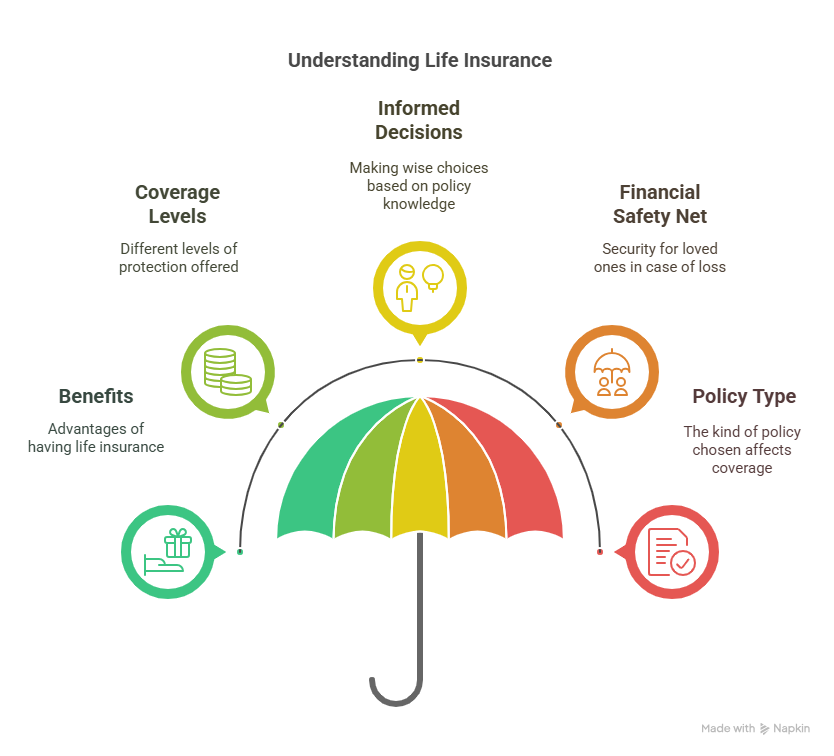Understanding life insurance policy benefits is crucial for securing your family’s financial future. Many individuals purchase life insurance without fully grasping what it entails.
Knowing what life insurance covers can help you make informed decisions about your policy. The importance of life insurance coverage cannot be overstated, as it provides a safety net for your loved ones in the event of your passing.
This article will delve into the various aspects of life insurance, breaking down the different types of policies and their respective coverage. By the end of this article, you will have a comprehensive understanding of what to expect from your life insurance policy.
Key Takeaways
- Understanding the benefits of your life insurance policy is essential.
- Different policies offer varying levels of coverage.
- Knowing what your policy covers can help you make informed decisions.
- Life insurance provides a financial safety net for your loved ones.
- The type of policy you choose will determine the coverage you receive.

What Life Insurance Covers: The Basics
The foundation of any life insurance policy lies in understanding what it covers and how it works. Life insurance is designed to provide financial protection to your loved ones in the event of your passing, but its benefits can extend beyond that.
Death Benefit Fundamentals
The primary component of life insurance is the death benefit, which is the amount paid to your beneficiaries upon your death. This benefit can help cover funeral expenses, outstanding debts, and ongoing living costs, ensuring that your family is financially supported.
Living Benefits and Cash Value
Some life insurance policies, such as whole life and universal life insurance, accumulate a cash value over time. This cash value can be borrowed against or used to pay premiums. Additionally, certain policies offer living benefits, allowing you to access a portion of the death benefit if you’re diagnosed with a terminal illness.
Standard Policy Exclusions
It’s crucial to understand that life insurance policies often come with exclusions. Common exclusions include death resulting from suicide within a certain period after purchasing the policy, death while engaging in high-risk activities, and misrepresentation on the application. Understanding these exclusions is vital to knowing what is covered.
Coverage Breakdown by Policy Type
Different life insurance policies offer unique benefits and limitations, affecting the coverage they provide. Understanding these differences is crucial for selecting the right policy for your needs.
Term Life Insurance Protection
Term life insurance provides coverage for a specified period, typically ranging from 10 to 30 years. It pays a death benefit if the insured dies during the term but does not accumulate a cash value. This type of insurance is often chosen for its affordability and simplicity.
Whole Life Insurance Benefits
Whole life insurance, also known as permanent life insurance, covers the insured for their entire lifetime, provided premiums are paid. It includes a cash value component that grows over time. Whole life insurance offers a guaranteed death benefit and a guaranteed cash value accumulation.
Universal Life Insurance Features
Universal life insurance is a flexible premium policy that combines a death benefit with a savings component. It allows policyholders to adjust their premiums and death benefits within certain limits. The cash value grows based on interest rates or investment performance.
Specialized Policies and Riders
Specialized policies and riders can be added to a basic life insurance policy to enhance or modify coverage. Examples include accidental death benefit riders and long-term care riders. These additions can provide additional financial protection against specific risks.
| Policy Type | Coverage Period | Cash Value | Premiums |
|---|---|---|---|
| Term Life | Specified term (e.g., 10-30 years) | No | Generally lower |
| Whole Life | Lifetime | Yes, guaranteed growth | Generally higher |
| Universal Life | Flexible, can be lifetime | Yes, based on interest or investments | Flexible |
Selecting Coverage That Meets Your Needs
Choosing the right life insurance coverage is a crucial decision that requires careful consideration of your financial responsibilities and goals. To make an informed decision, you need to assess your current financial situation and future obligations.
Evaluating Your Financial Responsibilities
Start by evaluating your financial responsibilities, including outstanding debts, mortgage, and dependents. This will help you understand the importance of life insurance coverage and determine the right coverage amount.
Coverage Amounts and Duration
Next, consider the coverage amount and duration that suits your needs. You can choose a policy term that aligns with your financial obligations, such as until your children are financially independent or until you retire.
Customizing Your Policy
Finally, customize your policy by adding riders or adjusting the coverage amount to suit your changing needs. This will ensure that you have the right coverage at the right time. You can work with your insurance provider to tailor a policy that meets your unique requirements.
Understanding Your Life Insurance Options
Choosing the right life insurance policy can be a daunting task, but understanding the different coverage options available can help. Life insurance policy benefits can provide financial security for your loved ones in the event of your passing.
A comprehensive life insurance coverage plan can include a range of benefits, from death benefits to living benefits and cash value accumulation. By evaluating your financial responsibilities and coverage needs, you can select a policy that meets your unique circumstances.
Life insurance coverage options vary widely, from term life insurance to whole life and universal life insurance. Each type of policy has its own features and benefits, and customizing your policy with riders and add-ons can provide additional protection.
By understanding your life insurance options and selecting a policy that aligns with your needs, you can enjoy peace of mind knowing that your loved ones are protected. Reviewing your comprehensive life insurance coverage regularly can help ensure that your policy remains relevant and effective.
FAQ
What is typically covered under a life insurance policy?
Life insurance policies typically cover a death benefit, which is paid out to beneficiaries upon the policyholder’s passing. Some policies, like whole life and universal life insurance, also accumulate a cash value over time, which can be borrowed against or used to pay premiums.
Are there any exclusions or limitations to life insurance coverage?
Yes, life insurance policies often have exclusions or limitations, such as the suicide exclusion clause, which typically states that the policy won’t pay out if the policyholder dies by suicide within a certain period (usually 2 years) after purchasing the policy. Other exclusions may include death resulting from certain activities or pre-existing medical conditions not disclosed during the application process.
Can I customize my life insurance policy to fit my needs?
Yes, many life insurance policies can be customized with riders or add-ons, which provide additional coverage or benefits. For example, a long-term care rider can help cover long-term care expenses, such as nursing home care or home health care. You can work with a licensed insurance professional to determine the best riders for your situation.
How do I determine the right coverage amount and duration for my life insurance policy?
To determine the right coverage amount, consider your financial responsibilities, such as outstanding debts, funeral expenses, and ongoing living expenses for dependents. You should also think about your income replacement needs and any future financial obligations, like college tuition or retirement savings. The coverage duration will depend on your specific needs, such as until your children are financially independent or until you retire.
Can I change or cancel my life insurance policy if my needs change?
Yes, you can typically make changes to your life insurance policy or cancel it if your needs change. However, be aware that surrender charges or penalties may apply if you cancel or significantly alter your policy. It’s essential to review your policy terms and consult with a licensed insurance professional before making any changes.
What is the importance of reviewing and updating my life insurance coverage?
Reviewing and updating your life insurance coverage is crucial to ensure it remains aligned with your changing needs and circumstances. As your financial situation, family dynamics, or goals evolve, your life insurance coverage should be adjusted accordingly to provide adequate protection and support for your loved ones.




